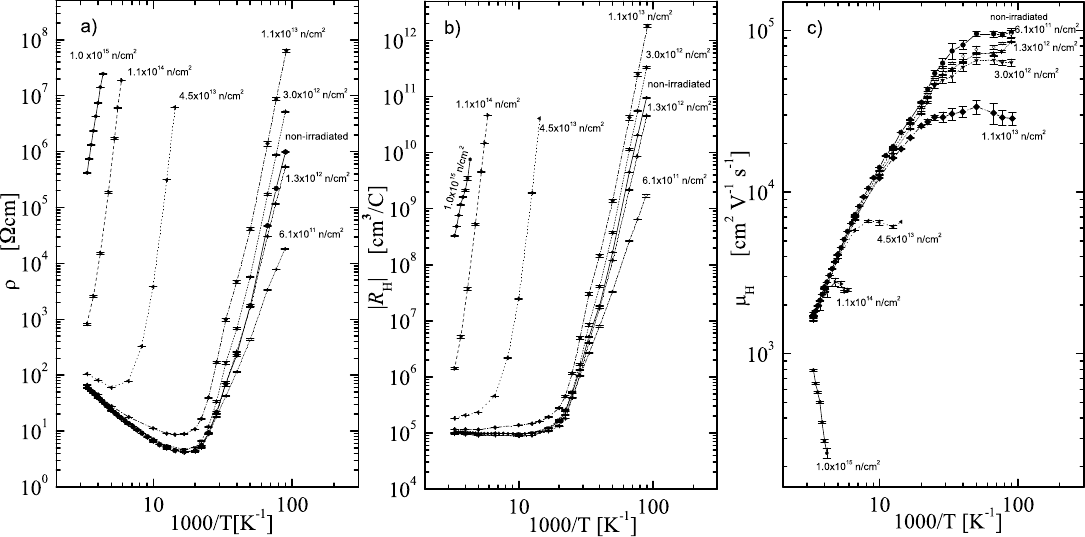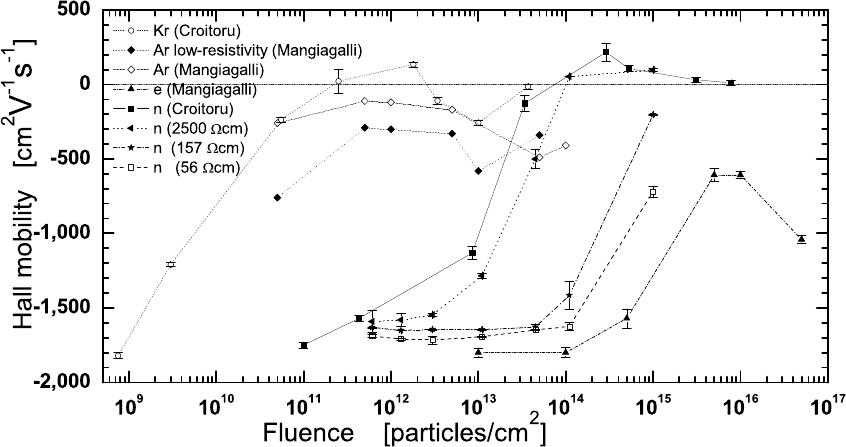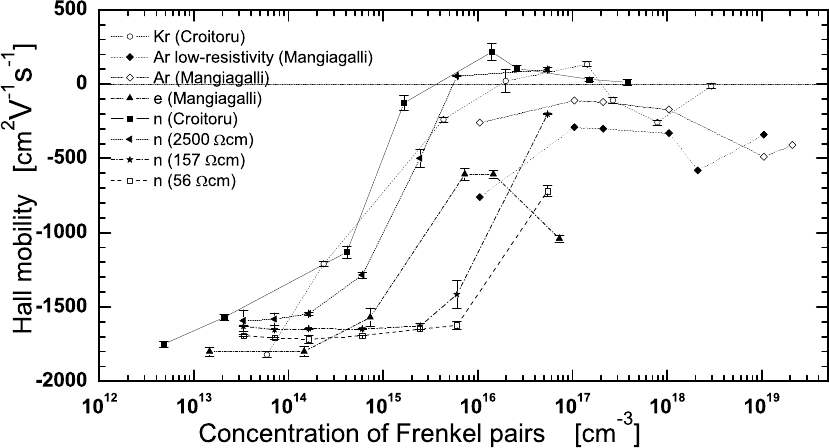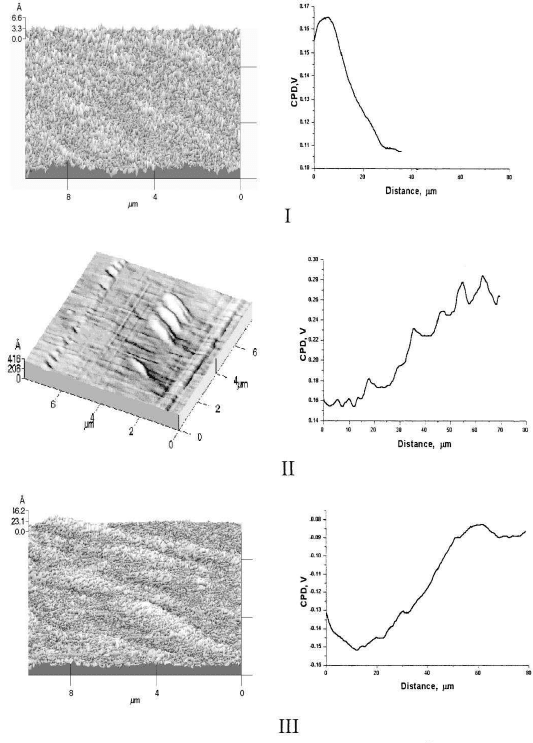Leroy C., Rancoita P.-G. Principles Of Radiation Interaction In Matter And Detection
Подождите немного. Документ загружается.


January 9, 2009 10:21 World Scientific Book - 9.75in x 6.5in ws-bo ok975x65˙n˙2nd˙Ed
410 Principles of Radiation Interaction in Matter and Detection
Fig. 4.34 (a) Resistivity (ρ) in Ωcm, (b) absolute value of the Hall coefficient [R
H
, see Eqs. (4.166, 4.169)] in cm
2
/C and (c) Hall mobility [µ
H
, see
Eqs. (4.171, 4.172)] in cm
2
V
−1
s
−1
as a function of the temperature from 300 down to 11 K (in 1000/T, where T is in K) for n-type silicon samples
with resistivities of ≈ 56 Ωcm before irradiation with fast neutrons: the experimental data are from [Consolandi, Pensotti, Rancoita and Tacconi
(2008)]. R
H
was observed to be negative before (e.g., for n-type silicon) and after irradiations, i.e., there was no change of the Hall-coefficient sign.

January 9, 2009 10:21 World Scientific Book - 9.75in x 6.5in ws-bo ok975x65˙n˙2nd˙Ed
Radiation Environments and Damage in Silicon Semiconductors 411
and Rattaggi (1998); Croitoru, Gubbini, Rancoita, Rattaggi and Seidman (1999a,b);
Mangiagalli, Levalois, Marie, Rancoita and Rattaggi (1999)]). At very large flu-
ences of fast-neutrons (i.e., above
‡
10
15
n/cm
2
), Kr-ions (i.e., above 10
13
Kr/cm
2
[Croitoru, Gubbini, Rancoita, Rattaggi and Seidman (1999a,b)]) and Ar-ions (i.e.,
above 10
14
Ar/cm
2
[Mangiagalli, Levalois, Marie, Rancoita and Rattaggi (1998)])
the resistivity is roughly that of the intrinsic silicon.
After irradiation with fast neutrons, the resistivity temperature-dependence
[Fig. 4.34(a)] from 300 down to 11 K was investigated for n-type silicon samples
with a resistivity of ≈ 56 Ωcm before irradiation [Consolandi, Pensotti, Rancoita
and Tacconi (2008)]. From 300 (1000/T ' 3.3) down to ≈ 60 K (1000/T ' 16.7)
and for a neutron fluence up to 3 × 10
12
n/cm
2
, the temperature dependence does
not exhibit a significant variation with regard to that before irradiation. However,
for temperatures lower than ≈ 50 K (1000/T = 20) and for a neutron fluence up
to 1.3 × 10
12
n/cm
2
, the resistivity values are lower than the corresponding non-
irradiated ones. For neutron fluences above 1.1 ×10
13
n/cm
2
a large departure from
the behavior of the non-irradiated sample is observed.
For both n- and p-type silicon, the Hall coefficient was measured after ir-
radiations with different type of particles. At large fluences of photons emit-
ted by a
60
Co-radioactive source, it was found that, while p-type silicon main-
tains the same conductivity type [i.e., the Hall coefficient remains positive;
see Eqs. (4.165, 4.169, 4.170)], the n-type silicon may change conductivity
type, i.e., from negative the Hall coefficient may become positive ([Konozenko,
Semenyuk and Khivrich (1969)] and references therein). In irradiations with fast-
neutrons and 3.8 MeV electrons, the Hall coefficients were observed to show a sim-
ilar behavior for n-type Fz and p-type silicon [Lugakov, Lukashevich and Shusha
(1982)], while no change of conductivity type [e.g., see Figs. 4.34(b)] occurred for
the n-type Cz
†
and oxygen enriched silicon samples with ρ = (56–157) Ωcm [Lu-
gakov, Lukashevich and Shusha (1982); Consolandi, Pensotti, Rancoita and Tacconi
(2008)]. Other experimental data confirmed that n-type silicon with high-resistivity
may change type of conductivity with irradiations, for instance, with fast-neutrons
and Kr-ions (e.g., see [Borchi and Bruzzi (1994); Biggeri, Borchi, Bruzzi and Lazanu
(1995); Biggeri, Borchi, Bruzzi, Pirollo, Sciortino, Lazanu and Li (1995); Croitoru,
Dahan, Rancoita, Rattaggi, Rossi and Seidman (1997); Croitoru, Gubbini, Ran-
coita, Rattaggi and Seidman (1999a,b); Mangiagalli, Levalois, Marie, Rancoita and
Rattaggi (1999); Consolandi, Pensotti, Rancoita and Tacconi (2008)] and references
therein). In low resistivity samples, no change in conductivity type was observed
in irradiations with Ar-ions [Mangiagalli, Levalois, Marie, Rancoita and Rattaggi
(1998)].
‡
The reader can see [Croitoru, Dahan, Rancoita, Rattaggi, Rossi and Seidman (1997); Croitoru,
Gubbini, Rancoita, Rattaggi and Seidman (1999a,b)].
†
These are samples grown by the Czochralski (pulled) method (e.g., see page 296) and contain
oxygen and carbon in higher concentrations with respect to those grown by the vacuum float-zone
(Fz) method.

January 9, 2009 10:21 World Scientific Book - 9.75in x 6.5in ws-bo ok975x65˙n˙2nd˙Ed
412 Principles of Radiation Interaction in Matter and Detection
As already mentioned, from combined measurements of the resistivity and Hall
coefficient we can determine the Hall mobility. The Hall mobility was observed
to decrease with increasing particle fluence (e.g., see [Borchi and Bruzzi (1994);
Biggeri, Borchi, Bruzzi, Pirollo, Sciortino, Lazanu and Li (1995); Croitoru, Dahan,
Rancoita, Rattaggi, Rossi and Seidman (1997, 1998); Mangiagalli, Levalois, Marie,
Rancoita and Rattaggi (1998); Croitoru, Gubbini, Rancoita, Rattaggi and Seidman
(1999b); Mangiagalli, Levalois, Marie, Rancoita and Rattaggi (1999); Consolandi,
Pensotti, Rancoita and Tacconi (2008)] and references therein). For low fluence of
fast-neutrons (≈ 9.9 × 10
10
n/cm
2
), the electron-mobility, which differs from the
Hall mobility by the Hall factor [e.g., see Eq. (4.172)], is given by:
µ
e,irr
∝ T
−α
,
where α ≈ 2.6 and 200 < T < 300 K [Croitoru, Gubbini, Rancoita, Rattaggi and
Seidman (1999b)]. The coefficient α was about 2.3, before irradiation [e.g., see
Eq. (4.174)].
Furthermore since one of the primary effects of irradiation is to cause displa-
cement damage (e.g., see Sect. 4.2.1) and, as a consequence, to generate deep
complex-defects (e.g., see Sect. 4.2.2), it is convenient to show the value of Hall
mobility as a function of the concentration of Frenkel-pairs (FP ) created in the
samples. In Figs. 4.35 and 4.36, the Hall mobility
‡
[Eq. (4.171)] is shown as a func-
tion of the particle fluence and FP, respectively, for irradiations with i) fast-neutrons
[Croitoru, Gubbini, Rancoita, Rattaggi and Seidman (1999a,b); Consolandi, Pen-
sotti, Rancoita and Tacconi (2008)], ii) 1.5 MeV electrons [Mangiagalli, Levalois,
Marie, Rancoita and Rattaggi (1999)], iii) 60 MeV/amu Kr-ions
††
[Croitoru, Gub-
bini, Rancoita, Rattaggi and Seidman (1999a,b)] and iv) 6.7 MeV/amu Ar-ions
[Mangiagalli, Levalois, Marie, Rancoita and Rattaggi (1998)]. The concentrations
of Frenkel-pairs for the irradiations with Ar- and Kr-ions were computed using
the SRIM-2003 code [Ziegler, Biersack and Littmark (1985a); Ziegler (2006)], for
those with electrons by means of the data reported in Sect. 4.2.1.5 and for those
with fast-neutrons by combining their spectral-fluence and the data reported in
Sect. 4.2.1.5. The experimental data show that i) there is more similarity in the
trend of data as a function of FP than as a function of the particle fluence [i.e.,
compare Figs. 4.35 and 4.36], ii) at low FP the Hall mobility differs slightly from
the electron Hall mobility expected in a non-irradiated and weakly doped n-typ e
silicon [e.g., see Eq. (4.172)], iii) a large decrease of the Hall mobility is observed for
FP & 2 × 10
14
cm
−3
, iv) in high-resistivity samples, a first change of conductivity
type may occur for FP & 10
15
cm
−3
(i.e., for fast neutrons and Kr-ions) and v) a
second change of conductivity type occurs for Kr-ions for FP & 2 × 10
17
cm
−3
.
After irradiation with fast neutrons, the temp erature-dependence of the Hall co-
efficient and mobility [Figs. 4.34(b) and (c)] from 300 down to 11 K was investigated
‡
In Figs. 4.35 and 4.36, the Hall mobility is shown maintaining the sign of the Hall coefficient,
instead of using its absolute value [see Eqs. (4.171–4.173)], and at room temperature.
††
The reader can find the definition of kinetic energies per amu in Sect. 1.4.1.

January 9, 2009 10:21 World Scientific Book - 9.75in x 6.5in ws-bo ok975x65˙n˙2nd˙Ed
Radiation Environments and Damage in Silicon Semiconductors 413
Fig. 4.35 Hall mobility (in cm
2
V
−1
s
−1
) at room temperature for n-type silicon as a function of the particle fluence in particles/cm
2
(adapted
from [Leroy and Rancoita (2007)]): 60 MeV/amu Kr-ions (◦, high-resistivity) [Croitoru, Gubbini, Rancoita, Rattaggi and Seidman (1999a,b)],
6.7 MeV/amu Ar-ions (♦, for high-resistivity, and ¨, for low-resistivity) [Mangiagalli, Levalois, Marie, Rancoita and Rattaggi (1998)], 1.5 MeV
electrons (N, high-resistivity) [Mangiagalli, Levalois, Marie, Rancoita and Rattaggi (1999)], fast-neutrons (¥, high-resistivity) [Croitoru, Gubbini,
Rancoita, Rattaggi and Seidman (1999a,b)], fast neutrons (J, F and ¤ for 2500, 157 and 56 Ωcm before irradiation, respectively) [Consolandi,
Pensotti, Rancoita and Tacconi (2008)]. For the above data, before irradiation the resistivities of the high-resistivity samples are in the range
1 . ρ . 7 kΩcm, while . 100 Ωcm for low-resistivity samples. The sign of the Hall mobility is the sign of the measured Hall coefficient. The lines are
to guide the eye.

January 9, 2009 10:21 World Scientific Book - 9.75in x 6.5in ws-bo ok975x65˙n˙2nd˙Ed
414 Principles of Radiation Interaction in Matter and Detection
Fig. 4.36 Hall mobility (in cm
2
V
−1
s
−1
) at room temperature for n-type silicon as a function of the concentration of the Frenkel-pairs in cm
−3
(adapted from [Leroy and Rancoita (2007)]): the experimental data and corresponding symbols are the same of those shown in Fig. 4.35. The sign
of the Hall mobility is the sign of the measured Hall coefficient. The lines are to guide the eye.

January 9, 2009 10:21 World Scientific Book - 9.75in x 6.5in ws-bo ok975x65˙n˙2nd˙Ed
Radiation Environments and Damage in Silicon Semiconductors 415
for n-type silicon samples with a resistivity of ≈ 56 Ωcm before irradiation [Con-
solandi, Pensotti, Rancoita and Tacconi (2008)]. No change of the Hall-coefficient
sign was observed after irradiation, i.e., the Hall-coefficient was negative before
(e.g., for n-type silicon) and after irradiation. From 300 (1000/T ' 3.3) down to
≈ 60 K (1000/T ' 16.7) and for a neutron fluence up to 1.1 × 10
13
n/cm
2
, it is
observed a gradually reduction of the temperature-region extension in which the
Hall coefficient is almost constant [Figs. 4.34(b)]. This region is absent for samples
irradiated with fluences above 4.5×10
13
n/cm
2
. For temperatures lower than ≈ 50 K
(1000/T = 20) and for a neutron fluence up to 1.3 × 10
12
n/cm
2
, the Hall coeffi-
cient values are lower than the corresponding non-irradiated ones. In addition, the
experimental determinations [Figs. 4.34(c)] indicate i) at all temperatures the Hall
mobility of the non-irradiated sample is larger than that of irradiated ones and ii) for
these latter samples it gradually decreases with increasing fluence and temperature,
except at the largest fluence where it increases with increasing temperature.
As discussed in Sect. 4.2.2, the displacement damage generated by the inco-
ming particles results in the formation of defects with deep levels in the forbidden
energy gap. These investigations confirm that large concentrations of deep complex-
defects (e.g. see [Konozenko, Semenyuk and Khivrich (1969); Lugakov, Lukashevich
and Shusha (1982)] and references therein) are introduced in the silicon and, then,
at very large fluences the Fermi level is expected to approach the middle of the
forbidden gap
§
irrespective of the incoming particle type and initial kind of con-
ductivity. At the initial stage of irradiation, complex-defects, for instance vacancies
with impurity-atoms (donors or acceptors), are introduced that decrease the effec-
tive dopant concentration, while, at a later stage, divacancies and other intrinsic
defects (e.g, di-interstitial, four-vacancies) become predominant [Konozenko, Se-
menyuk and Khivrich (1969); Lugakov, Lukashevich and Shusha (1982)]. These
defects can be introduced as primary by the cascade mechanism or as secondary by
the diffusion of the primary defects. The introduction rate of complex-defects may
depend on the incoming particle type (e.g, see Table 9 at pages 155–157 of [Vavilov
and Ukhin (1977)] and [Konozenko, Semenyuk and Khivrich (1969); Mangiagalli,
Levalois and Marie (1998); Mangiagalli, Levalois, Marie, Rancoita and Rattaggi
(1999)] and references therein) and, also, may not be linearly dependent on fluence,
as sometimes observed for secondary defects. For example, in irradiations with pho-
tons emitted by a
60
Co-radioactive source, the divacancy concentration (interpreted
as a secondary defect [Konozenko, Semenyuk and Khivrich (1969)]) was determined
to be
C
d−v
= 5 × 10
2
× Φ
0.6
γ
[cm
−3
],
where Φ
γ
(in γ/cm
2
) is the photon fluence ([Konozenko, Semenyuk and Khivrich
(1969)] and references therein).
§
Many authors have experimentally determined that the Fermi level approaches the middle of
the forbidden gap after irradiation (e.g., see [Konozenko, Semenyuk and Khivrich (1969); Lugakov,
Lukashevich and Shusha (1982); Biggeri, Borchi, Bruzzi and Lazanu (1995); Mangiagalli, Levalois,
Marie, Rancoita and Rattaggi (1999)] and references therein).

January 9, 2009 10:21 World Scientific Book - 9.75in x 6.5in ws-bo ok975x65˙n˙2nd˙Ed
416 Principles of Radiation Interaction in Matter and Detection
After irradiation with large fluences, the measurement of the Hall coeffi-
cient allows one to determine the approximate free-carrier concentration
¶
using
Eqs. (4.165, 4.169, 4.170). As a consequence, the resistivity
k
can be estimated from
Eq. (4.168). It has to be noted that, for large fast-neutron fluences, the measured
resistivity was found to disagree with that derived by the combined measurement
of the Hall coefficient
∗∗
on the same sample [Croitoru, Dahan, Rancoita, Rattaggi,
Rossi and Seidman (1997)]. This indicates that a further understanding (as well as
investigations) of transport mechanism in irradiated semiconductors is needed.
4.3.6 AFM Structure Investigation in Irradiated Devices
Using optical and Atomic Force Microscopy (AFM) techniques along with micro-
hardness studies, the characteristics of p −n silicon detectors were widely investiga-
ted after fast neutron irradiations for fluences ranging from 10
11
n/cm
2
up to above
10
14
n/cm
2
(e.g., see [Golan et al. (1999, 2000, 2001)] and references therein). It
has to be noted that, above these fast-neutron fluences, the Hall coefficient was
observed to change sign in n-type substrate with resistivity of (4–6) kΩ cm (e.g., see
Sect. 4.3.5 and [Croitoru, Dahan, Rancoita, Rattaggi, Rossi and Seidman (1997);
Croitoru, Gubbini, Rancoita, Rattaggi and Seidman (1999a); Mangiagalli, Levalois,
Marie, Rancoita and Rattaggi (1999)]).
The physical change in the irradiated detector seems to be influenced by the
type of defects and their distribution in the bulk material (e.g., [Golan et al. (1999)]
and references therein). Investigations have shown morphological changes in silicon
detectors. High neutron fluences result in vacancy accumulations and large quanti-
ties of interstitial atoms creating dislocation accumulations, which increase the local
value of the micro-hardness. For instance, in Fig. 4.37 (left side) the AFM surface
topography [Golan et al. (2001)] of a cleaved sample along the p
+
− n doping-
distribution and substrate is shown for (I) a non-irradiated device, (II) a device
irradiated with a fast neutron fluence of 5. 28 ×10
14
n/cm
2
and (III) a device irradi-
ated with a fast neutron fluence of 3.12 × 10
15
n/cm
2
. For a non-irradiated sample
[left side of Fig. 4.37 (I)], the defects are homogeneously distributed on the surface
of the detector. At large neutron fluences [left side of Figs. 4.37 (II) and 4.37 (III)],
accumulations of defects are more observable. An additional set of measurements
was carried out on these devices in order to scan the Contact Potential Difference
(CPD) along the substrate depth (right side of Fig. 4.37). A sensitivity of less than
10 mV was achieved at an applied bias voltage of 5 V. For the non-irradiated sam-
¶
To determine the free carrier concentration (e.g., see [Konozenko, Semenyuk and Khivrich
(1969); Lugakov, Lukashevich and Shusha (1982)]), r
e
= r
h
' 1 and b ≈ 3 (e.g., see [Lugakov,
Lukashevich and Shusha (1982)]) is assumed in Eq. (4.165), or, the temperature dependence of
the Hall factor in Eqs. (4.169, 4.170) is that one given in [Messier and Merlo-Flores (1963)].
k
One makes the assumption that µ
h
is slightly affected by the irradiation and b ≈ 3
(e.g., see [Croitoru, Dahan, Rancoita, Rattaggi, Rossi and Seidman (1997)]).
∗∗
b was assumed to vary in the range 1 < b < 3.3 (e.g., see [Croitoru, Dahan, Rancoita, Rattaggi,
Rossi and Seidman (1997)]).

January 9, 2009 10:21 World Scientific Book - 9.75in x 6.5in ws-bo ok975x65˙n˙2nd˙Ed
Radiation Environments and Damage in Silicon Semiconductors 417
Fig. 4.37 (left side) Atomic Force Microscope (AFM) surface topography of a cleaved sample
along the p
+
− n doping-distribution and substrate; (right side) Contact Potential Difference
(CPD), in units of V, as a function of the depth in µm of silicon detector junctions with n-type
silicon substrate and resistivity of about 6 kΩ cm (before irradiation) (reprinted from Microelect.
Reliab. 41, Golan, G. et al., Inversion phenomenon as a result of junction damages in neutron
irradiated silicon detectors, 67–72, Copyright (2001), with permission from Elsevier, e.g., for the
list of the authors see [Golan et al. (2001)]: (I) for a non-irradiated device, (II) for a device
irradiated with a fast-neutron fluence of 5.28 × 10
14
n/cm
2
and (III) for a device irradiated with
a fast neutron fluence of 3.12 × 10
15
n/cm
2
.
ple [right side of Fig. 4.37 (I)], the behavior of the contact potential follows that
expected in the junction region. In this region, the maximum potential of 0.165 mV
is approximately in agreement with that predicted by mean of Eq. (6.12) when the
free carrier concentrations of the n-type substrate and p
+
-region are taken into ac-
count. In addition the width of the depleted region is ≈ 20 µm, i.e., in agreement
January 9, 2009 10:21 World Scientific Book - 9.75in x 6.5in ws-bo ok975x65˙n˙2nd˙Ed
418 Principles of Radiation Interaction in Matter and Detection
with that expected from Eq. (6.26). For samples irradiated with the largest fluence
(i.e., 3.12×10
15
n/cm
2
), the contact potential seems to exhibit an inverted behavior
[right side of Fig. 4.37 (III)]. Other measurements of CPD as a function of the depth
position (Figure 2 in [Golan et al. (2001)]) have provided values lower than those
shown in Figs. 4.37 (II) and 4.37 (III) (right side). These later data might indicate
a reduced space-charge region.
January 9, 2009 10:21 World Scientific Book - 9.75in x 6.5in ws-bo ok975x65˙n˙2nd˙Ed
Chapter 5
Scintillating Media and Scintillator
Detectors
The conversion of the energy deposited by incoming particles or radiation into
photons can lead to particle detection, energy determination and discrimination
between particles of different masses. Therefore, the use of scintillating materials,
or the construction of detectors enhancing the
˘
Cerenkov or the transition radiation
effects, can be of great use in many application fields, such as high-energy physics
or medical imaging. The photons emitted in such detectors must be transported,
by light guides, to photosensitive devices, e.g., photomultipliers, in order to be
collected. In this chapter, the organic and inorganic scintillators will be reviewed,
as well as the
˘
Cerenkov and transition radiation detectors, with many examples. A
section will also be devoted to the description of the light transport and detection
techniques.
5.1 Scintillators
Scintillators are materials in which large fractions of incident energy carried by
striking particles or radiation are absorbed and transformed into detectable pho-
tons (visible or near visible light), later converted into an electric signal. They are
used in many applications, e.g., as detecting elements of calorimeters or in medical
imaging. This section will put an emphasis on calorimetric applications. Medical
applications will be discussed in the chapter devoted to medical physics.
There are two types of light emission: fluorescence and phosphorescence. Fluo-
rescence corresponds to prompt light emission (ns → µs) in the visible wavelength
range and is temperature independent. Phosphorescence corresponds to light emis-
sion over a longer period of time (µs → ms, even hours dep ending on the material)
with longer wavelengths compared to fluorescence and is temperature dependent. In
practice, only fluorescence, characterized by fast light emission, is useful for the de-
tection of particle or nuclear radiation.
Inorganic and organic scintillators are used for radiation detection (e.g., see [Hof-
stadter (1974); Knoll (1999)] and references therein). As will be seen later, different
mechanisms are at the origin of light production in these two types of scintillators.
419
